Text from http://www.saveyourheritage.com/history_of_south_africa.htm visited on 20 November 2010
South Africa. Other than Germany probably the most misunderstood White country in the world. A country that has now degenerated into anarchy. Let's take an unbiased look at their noble history.
| After the British decided against establishing a colony at the Cape of Good Hope, the Dutch realized it had strategic and economic importance. On commission for the Dutch East India Trading Company (VOC) the merchant Jan van Riebeeck anchored in the bay at the foot of Table Mountain on April 6, 1652. Remember, this was just a few years after the Dutch had established their colony in America! The first settlement was Cape Town, which is still called the Mother City to this day. |
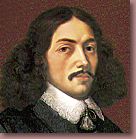 |
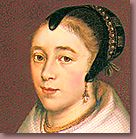 |
| |
Jan van Riebeeck |
Frau van Riebeeck |
Van Riebeeck had with him 82 men and 8 women, including his wife. His job was to establish a base to provide the Company's ships with fresh groceries including meat and vegetables for their journey from Europe to Asia.
| The first thing van Riebeek and his men did was erect the "Fort de Goede Hoop" for their protection. Then they laid out a garden and started to grow fruit and vegetables. They tried to obtain meat provisions through trade with the natives, the Khoikhoi. They're a historical division of the Khoisan ethnic group, who were the native Black Africans of southwestern Africa, closely related to the Bushmen. They had lived in southern Africa since the 5th century AD and, at the time of the arrival of Riebeek and his men practiced extensive pastoral agriculture. |
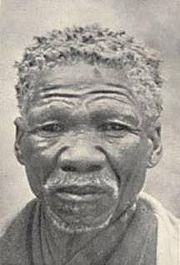 |
| |
"Old Cape" Khoikhoi Male |
The relationship with the Khoikhoi wasn't friendly and the company authorities made deliberate attempts to restrict contact. Partly as a consequence, VOC employees found themselves faced with a labor shortage. To remedy this, they released a small number of Dutch from their contracts and permitted them to establish farms, with which they would supply the VOC settlement. This arrangement proved highly successful, producing abundant supplies of fruit, vegetables, wheat and wine; they also later raised livestock. The small initial group of free burghers, as these farmers were known, steadily increased in number and began to expand their farms further north and east into the territory of the Khoikhoi.
| During the first winter 20 of Riebeeck's men died. Yet the settlement started to flourish. The number of sailors who anchored at the Cape to stock up on milk, meat and vegetables grew steadily. The construction of a pier rendered the bay safer and even more attractive. Soon there were workshops to repair ships and a hospital for the ill. |
 |
| |
1683 painting of Table Bay by Smit |
With the rapid development of the port the need for labor increased dramatically. Firstly slaves and politically banned people were imported from Indonesia (Java and Sumatra). These slaves and their descendants, including the ones who intermarried with the Dutch, became known as the Cape Coloureds and Cape Malays. Over time, the Khoisan, their European overseers, and the imported slaves mixed, with the offspring of these unions forming the basis for today's Colored population.
Soon Dutch Calvinists began arriving by the thousands. In 1688, a large group of French Huguenots who were fleeing religious persecution at home, settled at the Cape. Also arriving were smaller numbers of Frisians, Germans, Flemish and Walloons. This group made up what was to become the Trekboers that expanded and settled South Africa. They spoke Afrikaans, a language derived from the 17th century Dutch. Today Afrikaans is one of the official languages of South Africa but it is also spoken in Namibia, Botswana, Lesotho, and Swaziland. There are significant groups in Argentina who speak Afrikaans and over 100,000 in Great Britain. Those who speak Dutch and Afrikaans can easily understand each other.
Like their Khoikhoi counterparts, the Afrikaners, too, continued to expand into the rugged hinterlands of the north and east. Many began to take up a semi-nomadic pastoralist lifestyle, in some ways not far removed from that of the Khoikhoi they displaced. In addition to its herds, a family might have a wagon, tent, Bible, and a few guns. As they became more settled, they would build a mud-walled cottage, frequently located, by choice, days of travel from the nearest European settlement. These were the first of the Trekboers (wandering Farmers, later shortened to Boers and then called Afrikaners), completely independent of official controls, extraordinarily self-sufficient, and isolated. Their harsh lifestyle produced individualists who were well acquainted with the land. Like many pioneers with Christian backgrounds, the burghers attempted to live their lives based on teachings from the Bible.
 |
 |
 |
| Trek Boer crossing the Karoo - 1898 painting |
Trek Boers on the Karoo |
Map of Trek Boer Expansion |
Because the demand for agricultural land, especially pastures, grew continuously, the settlement steadily spread from Table Bay towards the north and north-east. The Khoikhoi, also called Hottentots, were forced to recede, although they strongly resisted the expansion of the Cape settlers. In 1659, a Khoikhoi uprising resulted in complete defeat, and they had to retreat to the north.
From the beginning of the 18th century the Cape settlers expanded their territory towards the north and the east. These settling movements were led by the Trek Boers who penetrated the hinterland looking for grazing land for their cattle.
The Trek Boers preferred the free and unrestricted life on their ox wagons and in tents to the more protected existence within the realms of town administration. The price they had to pay for their lifestyle was constant armed conflict with native peoples. First the Khoikhoi successfully resisted the conquest of their residential and grazing land.
And from the turn of the century it was the people of the Xhosa, living to the east, who stood up against the Trek Boers. Frequent skirmishes occurred, particularly in the Zuurveld in the east of the colony, to the boundary of the Great Fish River. In 1779, the first of the ferocious Xhosa wars broke out.
In the town communities the danger of a confrontation was also growing. Here the opposing parties were on one hand the citizens, aspiring to political autonomy, and on the other hand a weak, corrupt and almost bankrupt colonial administration. The townspeople demanded their independence from the colonial administration. In Swellendam and Graaff-Reinet, the first Republics were proclaimed, although they only existed for a short time.
The power struggle between citizens and administration ended with the landing of British ships at the Cape and the annexing of the colony to the United Kingdom in 1795.
THE GREAT TREK
The historical events in 19th century South Africa are marked by the "Groot Trek". Starting in 1835, more than 10,000 Boers, the Voortrekkers (Pioneers), left the Cape Colony with their families and went north and north-east. The reasons for this mass exodus were their economic problems, the threatening danger of conflict with the Xhosa, who settled on the other side of the Fish River, and primarily, discontent with the English colonial authorities who didn't provide sufficient protection and had forbidden the slave trade and postulated the equality of whites and non-whites
In the border area at the Fish River constant conflicts with the Xhosa occurred and the central government in Cape Town was neither willing nor able to give the Boers efficient military protection. Absolutely incomprehensible to the conservative Boer communities was the approach of the British colonial government towards the black inhabitants of the colony, who were held as slaves on most of the white farms. From 1833 on the slave trade was declared illegal and the "Emancipation Act" demanded that white masters set their slaves free, against payment of a small compensation by the state. The Voortrekkers felt that the British policy destroyed their traditional social order which was based on racial separation, and would undermine white predominance, which they saw as God's own will.
The Great Trek was organized in resistance to the politics of the Cape government. In 1835, the first groups set out. Under the leadership of Louis Trichardt and Hans van Rensburg, they opened up the north of today's Mpumalanga. Other groups, under the command of Andries Pretorius, Gert Maritz and Piet Retief followed. In the area around ThabaNchu in what would become the Orange Free State, a huge Boer camp of 5,000 Voortrekkers eventually gathered where the trekkers established a republic. Following disagreements among their leadership, the various Voortrekker groups split apart. While some headed north, most crossed the Drakensberg into Natal with the idea of establishing a republic there.
They thought they had found their promised land, vast tracts of apparently uninhabited grazing lands. There was space enough for their cattle to graze and their culture of anti-urban independence to flourish. Little did they know that what they found was disorganized bands of black refugees who had been pushed out of earlier lands.
Since the Zulus controlled this territory, the Voortrekker leader Piet Retief, paid a visit to King Dingaan. Dingaan promised them land in payment for a favor. A neighboring tribe had stolen cattle from Dingaan and he wanted it back. Retief went to the neighboring tribe and bartered with the king who returned the cattle. After receiving the specified cattle, Dingaan invited Retief and his men into his kraal, where they were given all the land between the Zimvubu and Tugela rivers up to the Drakensberg. The treaty between the two men currently sits in a museum in The Netherlands. As a celebration, Dingaan invited Retief and all his men to come and drink Tswala (Traditional Zulu Beer) in his kraal. While drinking and being entertained by Zulu dancers, Dingaan cried out "Bulala amatakati" (Kill the wizards), as Dingaan couldn't conceive how it would be possible for Retief to obtain his cattle without using magic. Dingaan's men, having taken Retief's men by surprised, dragged the men to a hill "Hloma Mabuto" where, one by one, they were all slaughtered, leaving Retief for last so that he could watch. After the massacre, they went back to the encampment where Retief and his fellow farmers had left their wives, children and livestock. Taken by surprise 500 of the women, children and remaining farmers were also raped and slaughtered. Those that managed to get away did so without many of their guns and animals. A missionary, Rev. Owen, had seen all of this take place and approached Dingaan in order to give the dead an appropriate burial. While the reverend and a helper of his were burying the dead and reading them their last rights, they happened to come across Retief's rucksack, still containing the treaty and a few personal belongings.
The Voortrekkers, now worn out through the death of their second leader Gert Maritz, and through internal quarrels, were at the end of their power. Only their newly elected leader Andries Pretorius was successful in consolidating the group and preparing it for a retaliatory strike against the Zulu king. On December 16, 1838 the Zulus were completely defeated in the famous "Battle of Blood River". This enabled the founding of the first short-lived Boer Republic in Natal, with Pietermaritzburg as its capital. By 1842, British troops occupied Port Natal, today's Durban, and annexed the hinterland as a Crown Colony. The Voortrekkers retreated behind the Drakensberg.
THE BATTLE of BLOOD RIVER
After the Voortrekkers had failed to negotiate with the Zulus the secession of land for settling and grazing, and had endured a number of catastrophic assaults, they assembled at the Ncome River for a decisive battle. On December 16, 1838, 464 Boers under the command of Andries Pretorius defeated more than 10,000 Zulu warriors. There was so much bloodshed that the Ncome River reportedly ran red. Hence the name, blood river. The deeply religious Boers did not ascribe the military victory to their technically superior armaments, but interpreted it primarily as a sign of God. Before the battle, they had prayed and made a vow that if God would grant them victory over the Zulus, they would commemorate the event annually. With that battle behind them, they believed even more strongly that white predominance over blacks is God's own will.
The monument at the Blood River, a fort of cast-bronze wagons, brings to life the terrible events of 1838, which meant the beginning of the end of the Zulu Kingdom. This monument stood alone for many years as a reminder exclusively of the heroism of the white settlers, who suffered no fatalities at Blood River on that day.

Bronze cast wagon monument at Blood River
The White Boers, vastly outnumber 464 to 10,000 Zulu warriors, won a decisive victory on December 16, 1838.
Not one Boer died. 3000 Zulu Warriors died |
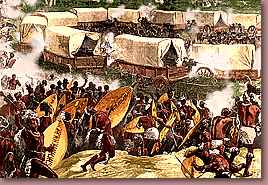
Painting of the Battle of Blood River |
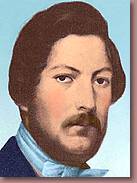
Andries Pretorius |
Finally, in December 1998, a memorial for the 3,000 Zulu soldiers who died in the battle, was inaugurated by Zulu Chief Mangosuthu Buthelezi across the river from the Afrikaner monument. The historic anniversary of the 'Day of the Vow' has been renamed 'Reconciliation Day' in the New South Africa.
NATAL
The Portuguese sailor Vasco da Gama reached the bay of today’s Durban on Christmas Day 1497. He named it "Rio de Natal", Christmas River. From that time on, the bay was a frequent port-of-call for sailors and merchants, but not until 1823 did a real settlement start to develop. In 1835, Port Natal was renamed Durban after the then Governor of the Cape Colony, Sir Benjamin Durban. Life in the small harbor town was very precarious. The Zulus regarded Natal as their own territory and merely tolerated the white settlers, because the port was useful to them as a trading post.
When the Voortrekkers came to Natal in 1836, and fierce battles with the Zulus were on the daily agenda, Durban was also frequently threatened by attacks. After the defeat of the Zulus in the Battle of Blood River, there was peace for a while, but soon the British and the Voortrekkers started to fight for supremacy over Natal. Ultimately, the bitter conflicts were decided in favor of the British. In 1844, Natal became a Crown Colony and the Voortrekkers retreated.
| In 1879, the British laid claims on the whole of Zululand and gave Zulu King Cetshwayo a practically unacceptable ultimatum. In the resulting Anglo-Zulu War, the British initially suffered a high number of casualties. The battle at the Isandlwana Mountain on 22 January, 1879 was particularly disastrous. About 20,000 Zulu soldiers overran the British army camp. Despite their superior armament, the British could not cope with the power of the attack. Many just covered their faces with their hands waiting to be stabbed through, others crept into their tents or tried to run away. Within a few hours, almost 2,000 soldiers were savagely killed. At first this victory for the Zulu King shocked and petrified the British. However, England decided to send more troops and the Anglo-Zulu War continued with heavy loss of lives, until it ended in victory for the British in 1887. KwaZulu was annexed by Natal. The northern border is the Tugela River. |
 |
| |
Battle of Isandlwana
Painting by Charles Fripp |
THE BOER REPUBLICS
The Boers meanwhile persevered with their search for land and freedom, ultimately establishing themselves in various Boer Republics, the Transvaal or South African Republic and the Orange Free State. For a while it seemed that these republics would develop into stable states, despite having thinly-spread populations of fiercely independent Boers, no industry, and minimal agriculture. Then the discovery of diamonds near Kimberley in 1869 changed everything and turned the Boers' world on its head. The first diamonds came from land belonging to the Griqua, but to which both the Transvaal and Orange Free State laid claim. Britain quickly stepped in and resolved the issue by annexing the area for itself.
The discovery of the Kimberley diamond mines unleashed a flood of European and black laborers into the area. Towns sprang up in which the inhabitants ignored the separation of whites and blacks. The Boers expressed anger that their impoverished republics had missed out on the economic benefits of the mines.
ANGLO-BOER WARS
After the Voortrekkers were defeated by the British in Natal in 1842, the Great Trek moved on further north-east and eventually the trekkers settled north and south of the Vaal river. First, they formed the independent Transvaal to the north, which would later become the South African Republic.
In the meantime, the Cape Colony had spread further and all the land between the Vaal and Orange rivers was declared British territory in 1848. The English, however, had not taken into account the strong resistance of the Boers who had already settled there. Because the area was economically of little interest to them, they soon gave it up again. On the 23rd of February 1854, the contract of Bloemfontein was signed, which led to the foundation of the Orange Free State. The "Oranje Vrystaat" developed into a politically and economically successful republic. But this positive process was overshadowed by various negative events in the second Boer state, the South African Republic in Transvaal (today Mpumalanga). By now British sentiment was in favored of amalgamating their own colonies and the Boer republics into one union, with the primary purpose of gaining possession of the Transvaal gold mines.
Long-standing Boer resentment turned into full-blown rebellion in the Transvaal (under British control from 1877), and the first Anglo-Boer War, known to Afrikaners as the "War of Independence", broke out in 1880. The conflict ended almost as soon as it began with a crushing Boer victory at Battle of Majuba Hill February 27, 1881. The republic regained its independence as the Zuid-Afrikaansche Republiek ("South African Republic"), or ZAR. Paul Kruger, one of the leaders of the uprising, became President of the ZAR in 1883. Meanwhile, the British, who viewed their defeat at Majuba as an aberration, forged ahead with their desire to federate the Southern African colonies and republics. They saw this as the best way to come to terms with the fact of a white Afrikaner majority, as well as to promote their larger strategic interests in the area.
In 1879 Zululand came under British control. Then in 1886 an Australian prospector discovered gold in the Witwatersrand, accelerating the federation process and dealing the Boers yet another blow. The population of Johannesburg exploded to around 100,000 by the mid 1890s and the ZAR suddenly found itself hosting thousands of uitlanders, outside migrants, both black and white, with the Boers squeezed to the sidelines. The influx of Black labor in particular worried the Boers, many of whom suffered economic hardship and resented the foreign wage-earners.
The enormous wealth of the mines, largely controlled by European "Randlords", outside entrepreneurs, soon became irresistible for the British. In 1895, a group of renegades led by Captain Leander Starr Jameson entered the ZAR with the intention of sparking an uprising on the Witwatersrand and installing a British administration. This incursion became known as the Jameson Raid. The scheme ended in fiasco, but it seemed obvious to Kruger that it had at least the tacit approval of the Cape Colony government, and that his republic faced danger. He reacted by forming an alliance with Orange Free State.
The British Premier of the Cape Colony, Sir Cecil Rhodes, tried to achieve union with the Boers but failed. The situation peaked in 1899 when the British demanded voting rights for the 60,000 foreign whites on the Witwatersrand. Kruger rejected the British demand and called for the withdrawal of British troops from the ZAR's borders. When the British refused, Kruger declared war. The war was between the two Boer Republics of The Orange Free State and the South African Republic and the two British colonies of Cape and Natal. This Second Anglo-Boer War lasted longer than the first, and the British preparedness surpassed that of Majuba Hill. By June 1900, Pretoria, the last of the major Boer towns, had surrendered.

Paul Kruger
|

Sir Cecil Rhodes |
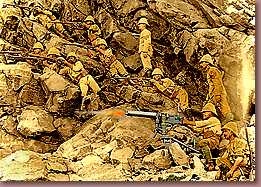
British Soldiers during the Anglo-Boer War |
The "Boer War" lasted three years. On the side of the Afrikaners there were 52,000 soldiers fighting against a contingent of 450,000 men under British command. The Afrikaners did initially achieve some spectacular successes, but very soon the tables turned. On March 13, 1900 Bloemfontein was occupied and on the 24th of May, the Orange Free State was declared British territory. Shortly afterwards Johannesburg and Pretoria fell, and on the 1st of September, Transvaal was annexed as a British colony.
Yet they underestimated Boer resistance and independence. Boer "bittereinders", those willing to fight to the "bitter end", continued for two more years with guerrilla-style battles. The British, under General Lord Kitchener responded with unequalled severity and brutality using scorched earth tactics. The Boer commandos were hunted systematically, the fields devastated, the harvests destroyed. The women and children, who were left destitute and homeless, were kept under horrific conditions in huge concentration camps. In total, more than 27,000 women and children died from famine, exhaustion and disease. This was 15 percent of the Boer population.

Lizzie van Zyl
British concentration camp |
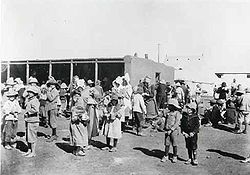
Afrikaner women and children
British concentration camp
|
Eventually the Boers realized that any further resistance would demand more senseless sacrifices, and peace negotiations began. On May 31, 1902 a superficial peace came with the signing of the Treaty of Vereeniging. Under its terms, the Boer republics acknowledged British sovereignty, while the British in turn committed themselves to reconstruction of the areas under their control.

Afrikaner soldiers in the Boer War
|
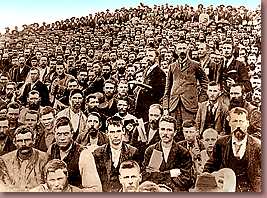
Boer prisoners of war |
UNION OF SOUTH AFRICA
During the immediate post-war years the British focused their attention on rebuilding the country, in particular the mining industry. By 1907 the mines of the Witwatersrand produced almost one-third of the world's annual gold production. But the peace brought by the treaty remained fragile and challenged on all sides. The Afrikaners found themselves in the ignominious position of poor farmers in a country where big mining ventures and foreign capital rendered them irrelevant. Britain's unsuccessful attempts to anglicize them, and to impose English as the official language in schools and the workplace particularly incensed them. Partly as a backlash to this, the Boers came to see Afrikaans as the volkstaal ("people's language") and as a symbol of Afrikaner nationhood. Several nationalist organizations sprang up.
The British moved ahead with their plans for union. After several years of negotiations, the South Africa Act of 1909 brought the colonies and republics - Cape Colony, Natal, Transvaal, and Orange Free State - together as the Union of South Africa. Under the provisions of the act, the Union remained British territory, but with home-rule for Afrikaners.
English and Dutch became the official languages. Afrikaans did not gain recognition as an official language until 1925. Despite a major campaign by Blacks and Coloreds, the voter franchise remained as in the pre-Union republics and colonies, and only whites could gain election to parliament.
Most significantly, the new Union of South Africa gained international respect with British Dominion status putting it on par with three other important British dominions and allies: Canada, Australia, and New Zealand.
THE XHOSA PEOPLE
At the time of white settlement of the Cape, Xhosa groups were living far inland, into the area between Bushman's River and the Kei River. Since around 1770, they had been confronted with the Trek Boers who approached from the west. Both the Boers and the Xhosa were stock-farmers. The competition for grazing land led first to quarrels between the two groups, and eventually it came to a number of wars.
The politics of the colonial government attempted to enforce the separation of white and black settlement areas with the Fish River as the border. But the more the colony developed into a modern state with a strong military organization, the more the whites tended towards a policy of land annexing and the subjugation of the black population. In the middle of the 19th century, all the land formerly inhabited by Xhosa was in the hands of white settlers.
With the founding of the South African Union in 1910, the British colony and the independent Boer Republics were united. A modern "democratic" state was formed. in which only the white population could execute the right to vote.
The black people were subjected to a policy of concealed expatriation. Through the Native-Land Law of 1913, first 7.5 percent, and later 13 percent of the land in South Africa was declared reservations for blacks. No white person was allowed to purchase land there and, vice versa, no black was allowed to buy land in the remaining 87 per cent of the territory of the Union. So the foundation of the disastrous policy of Apartheid was laid. In the sixties, the black settlement areas were declared autonomous Homelands. For the Xhosa people these were the Homelands of Ciskei and Transkei. Only after the first really free elections in South Africa in 1994 was the Homeland policy abolished, after which the areas were integrated into the new provinces.

Xhosa Women, Transkei (Eastern Cape) |
THE ZULU KINGDOM
Towards the end of the 18th century, all over southern Africa small tribal groups were amalgamating into larger communities. This was by no means a peaceful process, but the result of protracted wars. The rise of the Zulu Kingdom falls into this period. Through incredible atrocities and cruelties the infamous Zulu warrior Shaka gained control over a number of Zulu clans. He expanded his territory systematically. Shaka's warriors raided Zulu villages and burnt them down. Women and children were gored to death; young men were called up and chiefs tortured and forced into allegiance.
Shaka was the illegitimate son of the Zulu chief Senzangakhona and the young girl Nandi, a member of the Langeni clan. As a young man, Shaka joined the army of Dingiswayo and soon became its highest commander. With the support of Dingiswayo he gained supremacy over the Zulu clan, enforcing his claim against his opponents with the most ferocious brutality. Under Shaka the Zulu territory expanded phenomenally. All the clans had to subject themselves to the one leader. At the beginning of the 19th century, Shaka had created the most powerful kingdom in the whole of southern Africa.
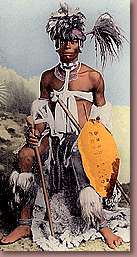
Shaka as a young warrior |

Zulu warriors, late 1800s |
Towards the end of his reign, Shaka used his power even more destructively. He chased his army from one battle to the next, and the cruelties against his enemies became more outrageous. Eventually Shaka was assassinated by his half-brother Dingane in 1828.
For southern Africa an irreversible process of restructuring came to an end with Shaka's death in 1828. Thousands of people had become refugees, fights between settlers and refugees broke out everywhere, and all these disturbances led to regroupings. At the end of this period, the small and widespread chief-led clans had disappeared and were replaced by bigger communities which had come together merely for reasons of safety and self-defense.
|
























